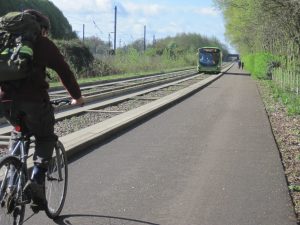
Improving transport infrastructure to support walking and cycling on the journey to and from work – active commuting – could help to promote physical activity and improve population health. However, there is limited evidence from intervention studies to guide policy and practice. We therefore took the opportunity presented by a ‘natural experiment’ to conduct a quasi-experimental study of the effects of new transport infrastructure on travel behaviour, physical activity and related wider health impacts among commuters.
The study was based around the opening of the Cambridgeshire Guided Busway, the longest guided busway in the world. Cambridge lies 80 km north of London and has a distinct cycling culture related to its flat topography, its large student population and the traffic congestion in its historic city centre. The busway links towns and villages to the north-west of the city with the Science Park, the city centre and the Biomedical Campus on the southern fringe. Buses run on a completely segregated guideway along most of the route, and a new high-quality traffic-free path for pedestrians and cyclists is provided alongside the guideway.
More about the study – plain English summary
What was the problem?
A shift towards more active lifestyles could be a ‘best buy’ for improving public health. Local authorities have a role to play in achieving this. For example, they can make it easier for people to walk or cycle as part of everyday journeys such as going to work. But it can be hard to study the effects of changing transport systems. This means that there is little good evidence to guide investment.
What did we do?
The Cambridgeshire Guided Busway is a new bus network with a high-quality off-road path for walking and cycling. It was opened in 2011 and is the longest of its kind in the world. We took the opportunity to find out more about how people travelled to work and how this changed as a result of the busway.
What did we find?
How people travelled to work depended on many different factors, ranging from childcare to parking. We studied these and took account of them in our research. We showed that, over time, people living closer to the busway were more likely to increase their cycling, and less likely to use their car, for commuting than those living further away. These changes could help to increase their overall physical activity and improve their health and well-being over time.
What does this mean?
We need to see whether or not similar results will be found in other places. In the meantime, our findings provide new evidence that changing transport systems can help to improve people’s health.
Study news
Read news and blogs about Commuting and Health in Cambridge.

 MRC Epidemiology Unit
MRC Epidemiology Unit